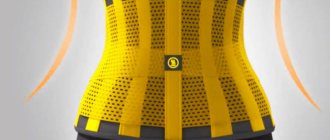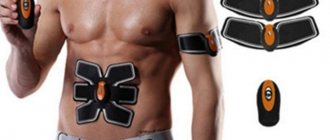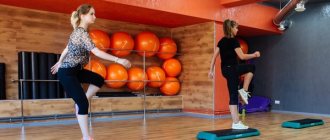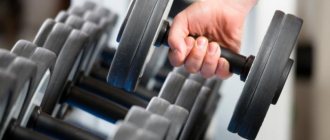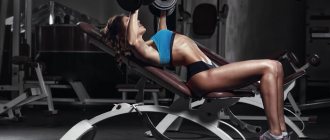Home ▸ Articles ▸ Workouts ▸ How much cardio do you need to lose weight?
Cardio is good for your heart and burns fat, and whether you love it or hate it, you should do it. Including if you want to lose weight.
But first of all, you need to cut calories in your diet. Only a calorie deficit will help you lose fat. Secondly, you need to lift weights. Without strength training, your diet will leave you weak and with flabby muscles. Weight training sends a message to your muscles that they are not allowed to burn out. Plus, the more muscle you have, the higher your resting metabolic rate and the more calories you'll burn each day in and out of the gym.
This brings us to cardio. There is aerobic (stationary) work and interval training. Both methods are good additions to your diet and weight training, but neither helps you get a lean body as much as you probably think.
The Naked Facts About Cardio Training
Aerobic training (steady state cardio)
Let's find out how many calories we burn with one of the most effective and popular workouts - running. According to a Harvard University study, a person weighing about 84 kg running at a speed of about 13 km per hour can burn 555 calories in 30 minutes.
Does this seem like a lot? Yes and no. That's more calories than you'll likely burn in the same amount of time lifting weights (266 calories), but you'll have to eat something at some point during the day. And this is a problem because it is much easier to consume calories than to burn them.
Let's say this 84-pound runner combines his workouts with a healthy, protein-rich meal that consists of 8 ounces of skinless chicken breast, one cup of brown rice, and as much broccoli as he can fit on his plate, seasoned with one tablespoon of olive oil. That's just under 600 calories.
In other words, just eating HEALTHY (most people don't eat that healthy) will largely cancel out the calories you burn in one intense aerobic workout session. Plus, you'll have to eat more than once a day, but you won't be going back to the gym over and over again, so eating even the cleanest foods can negate your calorie-burning efforts.
HIIT (interval training)
According to the American College of Sports Medicine (ACSM), alternating hard workouts with periods of light work or rest (which you probably know as high-intensity interval training, or HIIT) can burn more calories per minute than aerobic workouts.
This makes HIIT more time efficient, but because interval sessions are more intense than aerobic sessions, they may not last as long, meaning you won't burn more calories overall.
A study published in the American Journal of Human Biology compared stationary training to HIIT. The subjects alternated sessions in which they ran for 20 minutes without a break, keeping their heart rate at a moderate level, with workouts in which they did repeated 20-meter sprints.
After seven weeks, the total exercise time on the runs was naturally much longer, and so roughly 4,410 calories were burned in the stationary workout versus just 907 in the HIIT workout.
Moderate intensity interval training
According to Don Saladino, a New York-based trainer for celebrities such as Ryan Reynolds and Blake Lively, each of the three days allocated for cardio should be done with a different type of cardio, and there are three in total. “You have your stationary training, your HIIT and then moderate-intensity cardio,” says Saladino. This last category is what most people think of as HIIT, but it's actually not. It's a cross between true HIIT and aerobic work.
Moderate intensity interval training is everything between brisk jogging and walking. This could be jumping rope, battle rope waves, a circuit of weight-bearing exercises, or anything else that gets your heart rate up and allows you to give your heart a little boost as well as a little recovery before moving on.
This is different from HIIT, which is so intense that it can only be sustained for four to six seconds. We're talking full sprints, combat kicks, or Airdyne bike work. Since it has a big impact on both the nervous system and the muscles, you should limit your HIIT sessions to two workouts per week.
Finally, there's steady-state cardio, where all you have to do is set your heart rate between 120 and 150 beats per minute and hold it there for 30 to 60 minutes. You can do this workout almost every day if you want, but one day a week combined with HIIT and moderate-intensity interval training is enough.
Each type of cardio trains a different energy system, so it's important to develop each to get fit, but none can replace strength training and diet when it comes to getting your abs ready for the beach.
How much can you lose on an exercise bike?
Those who are looking closely at this sports unit, are looking for an answer to the question - how to lose weight on an exercise bike - and are accustomed to receiving information “in exact numbers”, should understand that this “equation” has too many terms that must be taken into account. If none of these terms are presented for consideration, then the answer to the question - how much weight will you lose on an exercise bike - may be diametrically opposite:
- no matter how much!
- as much as you like!
It is fundamentally wrong to assume that everything depends solely on the duration of training. Those who think that they can successfully lose n number of kilograms on an exercise bike, working on it (relatively!) for 12 hours a day, and in the remaining 12 hours “eating” their success with high-calorie food, are deeply mistaken.
Food will instantly return the calories lost during training. And the lack of results on the scales demotivates you for further exercise. The result? A sports unit that could be useful will stand in the corner for years, and its owner (who knows?) will write offended comments about the pointlessness of physical activity and the uselessness of a particular model.
Conclusion? An exercise bike for a month combined with your favorite buns and pies is the most useless pastime in your life. Any sports activity is effective only in combination with a diet. This is the main thing to learn. And we will talk about the duration of training, their most effective options for cutting and the frequency of training below.
The connection between cardio training and diet
A study from the Journal of Obesity looked at obese women who dieted or exercised, or combined diet and exercise, for a year to lose weight. Unsurprisingly, the exercise-diet group lost the most weight, about 20 pounds (and nearly 6% body fat).
However, women who simply dieted weren't far behind, losing about 7 kg (and 4% body fat). And women lost only about 2 kg and a little more than 1% fat with training alone.
All this means is that lifting weights and doing cardio is good, but unless you eat less than you did last month, the only six-pack you'll see will be a 6-pack of Budwiser.
If you cut calories and lift weights three to four days a week (three is the minimum number most trainers say you need to progress), you only need about three cardio days a week to see your abs, recommends Saladino .
Medical recommendations for cardio training
Any exercise on simulators is a physical activity. Cardio equipment is no exception. Even the healthiest person needs to listen to his body during training. Training should be stopped if your health worsens:
- Pain in the heart or chest area.
- Lack of air.
- Severe shortness of breath.
- Dizziness.
- Nausea.
- Headache.
- Weakness.
If you suffer from hypertension, you should definitely consult a doctor before training. Training is strictly contraindicated if:
- Severe degree of cardiovascular failure.
- Attacks of cardiac asthma.
- Thrombophlebitis.
- Tachycardia and frequent attacks of angina.
- Diabetes.
- Oncological diseases.
- Infectious diseases.
Most of the cardio equipment is accessible and seems easy to use. Without following the basic rules, you may not achieve the desired result and, in addition, harm your health. Therefore, it is very important to follow them when performing exercises. The basic and main rule of training is a properly selected program and load. The load on cardio equipment is selected depending on the person’s age, weight, and height. These indicators change, and with them the load on the human body changes. After all, the greater the load, the better the result - a wrong statement. Training quickly is another training mistake. Increasing the load and reducing the training time will not give a positive result. After all, cardio training is training with a high number of repetitions. It is important to remember that the fat burning process begins only after 15 minutes from the start of an intense workout.
What is EPOC and its role in weight loss?
You may have heard of a phenomenon called EPOC, which stands for excess post-exercise oxygen consumption. This is the period when your body recovers from exercise and burns calories faster than at rest. Some trainers talk a lot about EPOC, claiming that it's better than steady-state cardio because it allows you to burn calories while you're doing nothing (similar to how building muscle affects your metabolism). But the truth is that the EPOC effect is not that great.
According to the ACSM, we burn only 6% more calories during EPOC than during the actual workout (more if you ran very intensely—harder than most people are capable of, but still not that much).
So is cardio just a huge waste of time? Of course not. It still burns fat and improves endurance, and more importantly for your health, it strengthens your heart, lowers your blood pressure, helps you recover faster from strength training, and does many other beneficial things. But the fact remains that any exercise, when done without changing your diet, does not make much difference in weight loss.
See detailed instructions on how to implement each cardio method and enjoy your summer.
What parts of the body lose weight on an exercise bike?
This question, along with the question “How to spin an exercise machine to lose weight?” is most often asked by users before purchasing this or that sports unit. The answer lies not so much in the intensity of the training, but in the method of planting.
Let’s say you “urgently” need to tighten up your gluteal muscles for the beach season, the ideal condition of which makes both men and, in particular, representatives of the best part of humanity attractive. The principle of “getting on an exercise bike and losing weight as soon as you started pedaling at the speed of light” is clearly not enough. But the competent advice to slightly raise your buttocks above the saddle at the moment of the jerk is more than appropriate. With the help of such a seemingly not very significant emphasis, the buttocks are trained. But for this you will need a vertical (not horizontal!) simulator.
As for other parts of the body, first of all, the load will affect the hips, calves and lower legs. Many women are afraid to approach an exercise bike, believing that this unit can make their legs pumped up, like those who perform on the podium. Nothing like this! From any article about how to properly lose weight with an exercise bike, you will learn that we are talking specifically about a cardio machine, and practice on cardio machines a priori does not imply an increase in muscle mass to “Arnoldian” parameters. Cardio equipment is always a story about how to lose weight on an exercise bike, elliptical, or treadmill. But not about how to pump up on them.
Calves, thighs, buttocks get rid of excess fat, become more elastic, young, beautiful, lean. For men who, on the contrary, want to become a “bodybuilding icon” and look at the exercise bike with contempt, the question may arise: is it worth devoting time to it? 3x12 squats with a barbell on the shoulders, guess that's better?
Yes, but before you work out, sweat on the exercise bike to lose weight, otherwise your formidable quads will simply not be visible under a thick layer of fat. And less developed quadriceps and hamstrings (the back of the thigh) are easily recognized when there is no excess fat.
People often ask: will an exercise bike overcome cellulite? Let's answer directly: miracles will not happen, but the appearance of your legs will improve. Does the exercise machine work on the lower back muscles? Yes. And for healthy people who want to lose “side fat,” this is the greatest benefit. It dissolves with persistent exercise on an upright exercise bike. But those who suffer from lower back pain should consult a specialist before losing weight on this type of exercise machine. It is quite possible that a horizontal device, which also melts fat, is more suitable for you.
How to exercise on an exercise bike so that you can lose weight not only in your legs, but also in the muscles of your upper body? Let's be honest: this is not a trainer for the upper muscle group, but with a general weight loss, fat will be effectively melted from the top.
Cardio training scheme
HIIT
- Frequency: 1-2 times a week
- Exercises: sprints, hill sprints, stationary bike sprints, Versaclimber sprints, battle ropes
- How to do it: Warm up and then work as hard as possible for 4-6 seconds. Rest until you feel ready to repeat.
- Training time: 12–15 minutes
Moderate intensity interval training
- Frequency: 2-3 times a week
- Exercises: fast runs, jumping rope, weight circuits, sled pushes, battle rope waves
- How to do it: Create your own intervals. Any fast pace will do, but not the maximum pace for the interval. Alternate this with active recovery. For example, jump rope for 60 seconds and stretch your inner thighs for 30 seconds.
- Training time: 15–30 minutes
Stationary cardio
- Frequency: 1-3 times a week
- Exercise: jogging, cycling, swimming, walking
- How to do it: Work at a pace that keeps your heart rate between 120 and 150 beats per minute.
- You can wear a heart rate monitor or evaluate it as follows. Subtract your age from 220 to find your estimated maximum heart rate. Now place your index and middle fingers on the pulse in your neck and count for six seconds. Multiply this number by 10 to get the number of times your heart beats per minute at rest.
- Training time: 30–60 minutes




